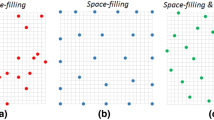Abstract
In this paper, the authors compare a Monte Carlo method and an optimization-based approach using genetic algorithms for sequentially generating space-filling experimental designs. It is shown that Monte Carlo methods perform better than genetic algorithms for this specific problem.
Access this chapter
Tax calculation will be finalised at checkout
Purchases are for personal use only
Preview
Unable to display preview. Download preview PDF.
Similar content being viewed by others
References
van Dam, E.R., Husslage, B., den Hertog, D., Melissen, H.: Maximin latin hypercube design in two dimensions. Operations Research 55(1), 158–169 (2007)
Gorissen, D., Crombecq, K., Hendrickx, W., Dhaene, T.: Adaptive distributed metamodeling. In: Daydé, M., Palma, J.M.L.M., Coutinho, Á.L.G.A., Pacitti, E., Lopes, J.C. (eds.) VECPAR 2006. LNCS, vol. 4395, pp. 579–588. Springer, Heidelberg (2007)
Gorissen, D., Tommasi, L.D., Crombecq, K., Dhaene, T.: Sequential modeling of a low noise amplifier with neural networks and active learning. Neural Computation & Applications 18(5), 485–494 (2009)
Gorissen, D., Turck, F.D., Dhaene, T.: Evolutionary model type selection for global surrogate modeling. Journal of Machine Learning Research 10(1), 2039–2078 (2009)
Johnson, M., Moore, L., Ylvisaker, D.: Minimax and maximin distance designs. Journal of Statistical Planning and Inference 26, 131–148 (1990)
Joseph, V.R., Hung, Y.: Orthogonal-maximin latin hypercube designs. Statistica Sinica 18, 171–186 (2008)
Lehmensiek, R., Meyer, P., Müller, M.: Adaptive sampling applied to multivariate, multiple output rational interpolation models with application to microwave circuits. International Journal of RF and Microwave Computer-Aided Engineering 12(4), 332–340 (2002)
Morris, M.D., Mitchell, T.J.: Exploratory designs for computer experiments. Journal of Statistical Planning and Inference 43, 381–402 (1995)
Rennen, G., Husslage, B., Dam, E.V., Hertog, D.D.: Nested maximin latin hypercube designs. Tech. Rep., Tilburg University (2009)
Sugiyama, M.: Active learning in approximately linear regression based on conditional expectation of generalization error. Journal of Machine Learning Research 7, 141–166 (2006)
Viana, F.A.C., Venter, G., Balabanov, V.: An algorithm for fast optimal latin hypercube design of experiments. International Journal for Numerical Methods in Engineering (2009)
Ye, K.Q., Li, W., Sidjianto, A.: Algorithmic construction of optimal symmetric latin hypercube designs. Journal of Statistical Planning and Inference 90(1), 145–159 (2000)
Author information
Authors and Affiliations
Editor information
Editors and Affiliations
Rights and permissions
Copyright information
© 2010 Springer-Verlag Berlin Heidelberg
About this paper
Cite this paper
Crombecq, K., Dhaene, T. (2010). Generating Sequential Space-Filling Designs Using Genetic Algorithms and Monte Carlo Methods. In: Deb, K., et al. Simulated Evolution and Learning. SEAL 2010. Lecture Notes in Computer Science, vol 6457. Springer, Berlin, Heidelberg. https://doi.org/10.1007/978-3-642-17298-4_8
Download citation
DOI: https://doi.org/10.1007/978-3-642-17298-4_8
Publisher Name: Springer, Berlin, Heidelberg
Print ISBN: 978-3-642-17297-7
Online ISBN: 978-3-642-17298-4
eBook Packages: Computer ScienceComputer Science (R0)




